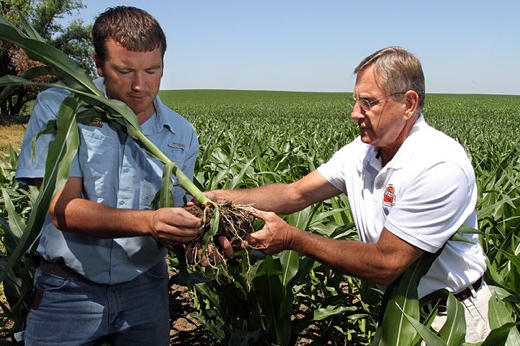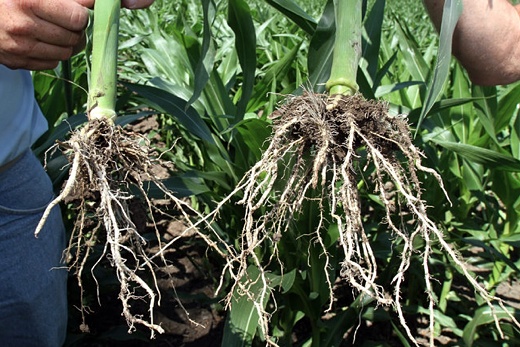SOURCE: Ken Taylor (taylork021@hawaii.rr.com)
SUBHEAD: Farmers and scientists are growing increasingly concerned about glyphosate's detrimental effect on soil.
By Stephanie Strom on 20 September 2013 for the New York Times -
(http://www.nytimes.com/2013/09/20/business/misgivings-about-how-a-weed-killer-affects-the-soil.html)

Image above: Jon Kiel, left, and Verlyn Sneller of the agriculture company Verity with a corn stalk produced without a glyphosate-based herbicide. From NYT article below. Photo by David Eggen.
Introduction by GMWatch on 20 September 2013 in Island Breath -
US farmers and scientists are growing increasingly concerned about glyphosate's detrimental effect on soil quality.
Monsanto is recommending additional soil inputs to counter the mineral deficiencies in plants caused by glyphosate - an example of the unsustainable nature of GM technology.
It's worth bearing in mind when reading the article below that the yield increases attributed by one commentator to GM are in fact the result of conventional breeding improvements. The GM traits are put into the best germplasm, and the best germplasm is a product of conventional breeding. (See Gurian-Sherman, D. (2009). Failure to yield: Evaluating the performance of genetically engineered crops, Union of Concerned Scientists. http://www.ucsusa.org/assets/documents/food_and_agriculture/failure-to-yield.pdf )
A recent study showed that the mostly non-GM farming practiced in the EU was more productive in terms of yield improvements than the GM farming practiced in the US. (See Heinemann, J. A., et al. (2013). Sustainability and innovation in staple crop production in the US Midwest. International Journal of Agricultural Sustainability: 1–18. http://www.tandfonline.com/doi/full/10.1080/14735903.2013.806408#.UjyJdRZYtEs )
SUBHEAD: Farmers and scientists are growing increasingly concerned about glyphosate's detrimental effect on soil.
By Stephanie Strom on 20 September 2013 for the New York Times -
(http://www.nytimes.com/2013/09/20/business/misgivings-about-how-a-weed-killer-affects-the-soil.html)

Image above: Jon Kiel, left, and Verlyn Sneller of the agriculture company Verity with a corn stalk produced without a glyphosate-based herbicide. From NYT article below. Photo by David Eggen.
Introduction by GMWatch on 20 September 2013 in Island Breath -
US farmers and scientists are growing increasingly concerned about glyphosate's detrimental effect on soil quality.
Monsanto is recommending additional soil inputs to counter the mineral deficiencies in plants caused by glyphosate - an example of the unsustainable nature of GM technology.
It's worth bearing in mind when reading the article below that the yield increases attributed by one commentator to GM are in fact the result of conventional breeding improvements. The GM traits are put into the best germplasm, and the best germplasm is a product of conventional breeding. (See Gurian-Sherman, D. (2009). Failure to yield: Evaluating the performance of genetically engineered crops, Union of Concerned Scientists. http://www.ucsusa.org/assets/documents/food_and_agriculture/failure-to-yield.pdf )
A recent study showed that the mostly non-GM farming practiced in the EU was more productive in terms of yield improvements than the GM farming practiced in the US. (See Heinemann, J. A., et al. (2013). Sustainability and innovation in staple crop production in the US Midwest. International Journal of Agricultural Sustainability: 1–18. http://www.tandfonline.com/doi/full/10.1080/14735903.2013.806408#.UjyJdRZYtEs )
Roundup Effects on Soil
By Stephanie Strom on 20 September 2013 for the New York Times

Image above: The roots appear healthier on the conventionally raised plant, right. From NYT article below. Photo by David Eggen.
He’s more concerned, though, about the soil. During heavy rains in the summer, the runoff from his neighbor’s farm soaked his fields with glyphosate-laden water.
“Anything you put on the land affects the chemistry and biology of the land, and that’s a powerful pesticide,” Mr. Von Arb said.
But 20 miles down the road, Brad Vermeer brushes aside such concerns.
He grows “traited,” or biotech, corn and soy on some 1,500 acres and estimates that his yield would fall by 20 percent if he switched to conventional crops and stopped using glyphosate, known by brand names like Roundup and Buccaneer.
In short, it is just too profitable to give up.
“Local agronomists are starting to say we have to get away from Roundup,” Mr. Vermeer said. “But they’re going to have to show me that conventional genetics can produce the same income.”
The local differences over glyphosate are feeding the long-running debate over biotech crops, which currently account for roughly 90 percent of the corn, soybeans and sugar beets grown in the United States.
While regulators and many scientists say biotech crops are no different from their conventional cousins, others worry that they are damaging the environment and human health. The battle is being waged at the polls, with ballot initiatives to require labeling of genetically modified foods; in courtrooms, where lawyers want to undo patents on biotech seeds; and on supermarket shelves containing products promoting conventionally grown ingredients.
Now, some farmers are taking a closer look at their soil.
First patented by Monsanto as a herbicide in 1974, glyphosate has helped revolutionize farming by making it easier and cheaper to grow crops. The use of the herbicide has grown exponentially, along with biotech crops.
The pervasive use, though, is prompting some concerns.
Critics point, in part, to the rise of so-called superweeds, which are more resistant to the herbicide. To fight them, farmers sometimes have to spray the toxic herbicide two to three times during the growing season.
Then there is the feel of the soil.
Dirt in two fields around Alton where biotech corn was being grown was hard and compact. Prying corn stalks from the soil with a shovel was difficult, and when the plants finally came up, their roots were trapped in a chunk of dirt. Once freed, the roots spread out flat like a fan and were studded with only a few nodules, which are critical to the exchange of nutrients.
In comparison, conventional corn in adjacent fields could be tugged from the ground by hand, and dirt with the consistency of wet coffee grounds fell off the corn plants’ knobby roots.
“Because glyphosate moves into the soil from the plant, it seems to affect the rhizosphere, the ecology around the root zone, which in turn can affect plant health,” said Robert Kremer, a scientist at the United States Agriculture Department, who has studied the impact of glyphosate on soybeans for more than a decade and has warned of the herbicide’s impact on soil health.
Like the human microbiome, the plants’ roots systems rely on a complex system of bacteria, fungi and minerals in the soil. The combination, in the right balance, helps protect the crops from diseases and improves photosynthesis.
In some studies, scientists have found that a big selling point for the pesticide — that it binds tightly to minerals in the soil, like calcium, boron and manganese, thus preventing runoff — also means it competes with plants for those nutrients. Other research indicates that glyphosate can alter the mix of bacteria and fungi that interact with plant root systems, making them more susceptible to parasites and pathogens.
“Antibiotics kill bacteria or reduce their growth, but some of those bacteria are useful,” said Verlyn Sneller, president of Verity, a small company that sells sugar-based fertilizers and water systems and works to persuade farmers like Mr. Vermeer to switch to conventional crops.
But research detailing the adverse effects with glyphosate is limited, and other studies counter such findings.
Monsanto, which sells Roundup and seeds resistant to glyphosate, says “there is no credible evidence” that the herbicide “causes extended adverse effects to microbial processes in soil.” A team of scientists from the Agriculture Department similarly reviewed much of the research and found the herbicide to be fairly benign. In response to a request from Monsanto, the Environmental Protection Agency recently increased the amount of glyphosate that is allowed on food and feed crops.
“Another factor that weighed on our minds quite a bit was that when you look at the yields of the three major glyphosate-resistant crops — corn, soybeans and cotton — there’s generally been a trend upwards that hasn’t changed since they were adopted,” said Stephen O. Duke, one of the U.S.D.A. scientists who worked on the review. “If there was a significant problem, I don’t think you’d see that.”
In defending the herbicide, Monsanto scientists and others cite research that has found that mineral deficiencies caused by glyphosate can be mitigated with soil additives. They also point to studies showing that the increase in plant diseases — which some have attributed to the use of the herbicide — instead could be linked to weaknesses in the variety of the plant that was chosen for genetic modification, or to the rise of “no-till” farming, which leaves plant materials that harbor pathogens on top of the soil where they can infect the next crop.
The company and the government continue to assess the impact of the herbicide.
The U.S.D.A. is conducting studies in Illinois, Mississippi and Maryland. Earlier this year, Monsanto bought parts of a company founded by J. Craig Venter, the first scientist to sequence the human genome, as part of an effort to develop microbes and other “agricultural biologicals.” The foray into microbes, said Robert T. Fraley, Monsanto’s chief technologist, is to improve yield and address some of the issues raised about glyphosate.
Until the debate is settled, some farmers in the Corn Belt are rethinking their methods.
Several years ago, Mike Verhoef switched to biotech corn and soybeans on his 330 acres in Sanborn, Iowa. He regularly rotated the two crops with oats, which are not genetically engineered, to help replenish the nutrients in the soil.
Almost immediately, he said problems emerged. He noticed that his soil was becoming harder and more compact, requiring a bigger tractor — and more gas — to pull the same equipment across it. The yield on his oats also dropped over time by about half.
“It took me that long to figure out what was going on,” Mr. Verhoef said. “What I was using to treat the traited corn and soy was doing something to my soil that was killing off my oats.”
Two years ago, he gave up and started growing conventional crops again. He is now working with Verity to improve soil quality and says his yields of conventional corn and soy are “average to above average” compared with neighbors growing biotech crops. It does take a bit more work, he acknowledges, since he has to walk his fields and figure out what mix of products is needed to treat the issues.
Although a neighbor told him that he would go broke growing conventional crops, Mr. Verhoef has no plans to go back to genetically engineered varieties. “So far, so good,” Mr. Verhoef said. “I’m not turning back, because I haven’t seen anything that is going to change my mind about glyphosate.”
.
2 comments :
The Times link doesn't work
Thanks Andy,
Sorry about that. It's fixed.
Juan
Post a Comment